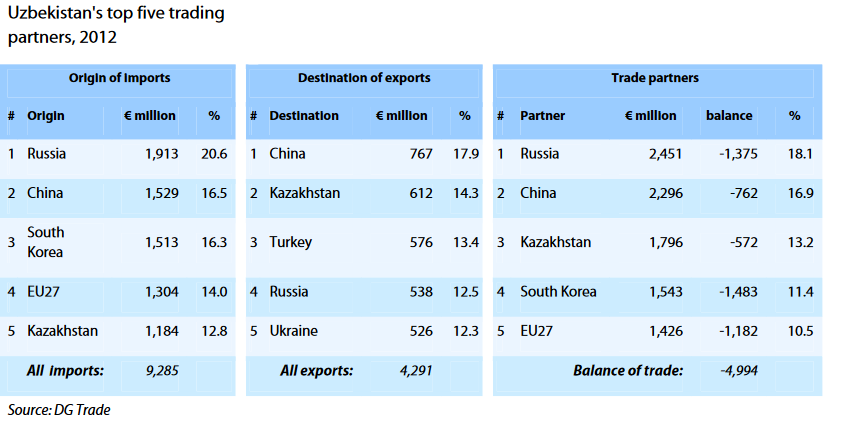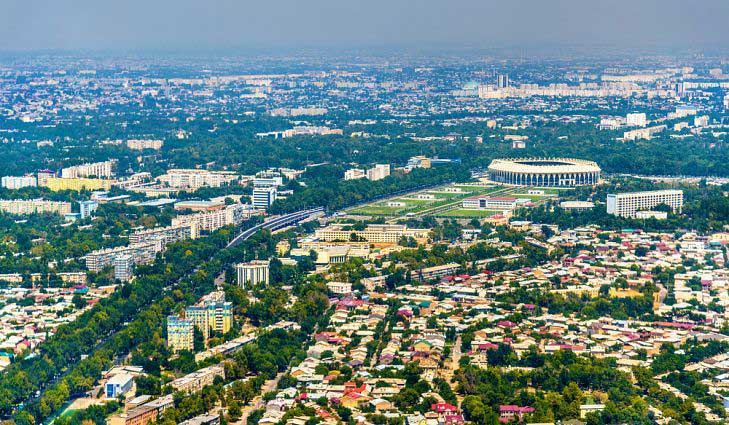Uzbekistan Textile & Apparel Industry
Uzbekistan, officially the Republic of Uzbekistan has an area of 447,400 square kilometers (172,700 square miles). It is the 56th-largest country (after Sweden). Bordering Turkmenistan to the southwest, Kazakhstan and the Aral Sea to the north, and Tajikistan and Kyrgyzstan to the south and east, Uzbekistan is not only one of the largest Central Asian states but also the only Central Asian state to border all of the other four. Uzbekistan also shares a short border with Afghanistan to the south. Uzbekistan is divided into 12 provinces (viloyats) with their ‘capital’ towns, 1 autonomous republic (Karakalpakstan), and 1 independent city (Tashkent).

Population, Language, Religion & Education:
The population of Uzbekistan in 2019 is 32.81 million, up from 29,559,100 in 2013 and 29,123,400 in 2011. This ranks Uzbekistan 43rd in the world. The rate of growth has slowed somewhat over time – from around 3.5% per year in the 1960s down to around 1.5% per year today – but if current growth rates continue, Uzbekistan will top 30 million people for the first time in 2016, and by 2020 will be home to around 33 million.
| Population | 32.81 billion |
| Growth rate | 0.94% |
| Life Expectancy | 72.77 years |
| GDP per Capita | $3,300 |
| Global rank | 43rd |
Language
The official state language is Uzbek. However, quite a few people in Tashkent and largest cities (including Uzbeks) still use Russian as their native language. Besides, majority of state organisations and businesses use Russian as their business correspondence language. Like in many other countries of the former Soviet Union, English is widely educated in Uzbekistan. However, English-speaking population is mostly based in Tashkent.
Religion
Uzbekistan is a secular state, where representatives of different religions and confessions live together. According to the official data, today there are 2225 registered religious organizations, 16 different religious confessions. This varied ethnic image of Uzbekistan states that there is high tolerance to the issue of religion in the country. The Constitution of Uzbekistan protects religious freedom. Everyone shall have the right to profess or not to profess any religion.
Education
Uzbekistan enjoys quite high literacy rate (among adults older than 15) which, in part, is attributable to the free and universal education system inherited from the Soviet Union times. Basic public education consists of two levels – 9-year primary and secondary school and 3-year College. University education can be obtained after completing the college education. There is also a number of technical colleges that are not considered as higher education.
Economic Overview of Uzbekistan
Major Trade Partners: (Uzbekistan official statistics, 2017)
| Country | Percentage |
| China | 18.5 % |
| Russia | 17.9 % |
| Kazakhstan | 7.7 % |
| Turkey | 5.7 % |
| USA | 0.8 % |
Uzbekistan initiates measures to focus on textile industry
Uzbekistan has initiated several measures to focus on the textile industry. The country is trying to grab foreign investments to implement various projects worth over $70 million. As an additional incentive for Chinese investors to kick-off their operations in Uzbekistan, a delegation of 33 representatives of China’s associations and textile companies was hosted recently by the Uztekstilprom Association in Tashkent. The Chinese delegation was headed by the Chinese National Council for Textiles and Clothing. The event aimed to boost cooperation between Uzbek and Chinese companies involved in the textile and apparel-knitting as well as the production and supply of finished textile products to the Chinese market. The forum was attended by the the leaders of the State Committee of Uzbekistan for Investments, UzTrade JSC of the Foreign Trade Ministry, the Economy Ministry. Representatives of the textile industry of the two countries were also present in the meeting. Bukhara, Kashkadarya, Samarkand and Syrdarya regions were represented as major locations where investment can be made.


Labor Force
The swelling of the working-age population has led to high rates of unemployment and underemployment. At the same time, despite relatively high average levels of education in the population, the shortage of skilled personnel in Uzbekistan is also a major constraint to future development. Russians and other nonindigenous workers traditionally were concentrated in the heavy industrial sectors, including mining and heavy manufacturing. With the independence of Uzbekistan and the outbreak of violence in several parts of Central Asia, many of these skilled personnel left the country in the early 1990s. In 1990 as many as 90 percent of personnel in Uzbekistan’s electric power stations were Russians. Because Russian emigration caused a shortage of skilled technicians, by 1994 half of the power generating units of the Syrdariya Hydroelectric Power Station had been shut down, and the newly constructed Novoangrenskiy Thermoelectric Power Station could not go on line because there was nobody to operate it. In the mid-1990s, training programs were preparing skilled indigenous cadres in these and other industrial sectors, but the shortfall has had a strong impact.
Economic Challenges
With the collapse of the Soviet Union, Uzbekistan faced serious economic challenges: the breakdown of central planning from Moscow and the end of a reliable, if limited, system of interrepublican trade and payments mechanisms; production inefficiencies; the prevalence of monopolies; declining productivity; and loss of the significant subsidies and payments that had come from Moscow. All these changes signaled that fundamental reform would be necessary if the economy of Uzbekistan were to continue to be viable. Traditionally a raw materials supplier for the rest of the Soviet Union, Uzbekistan saw its economy hard hit by the breakdown of the highly integrated Soviet economy. Factories in Uzbekistan could not get the raw materials they needed to diversify the national economy, and the end of subsidies from Moscow was exacerbated by concurrent declines in world prices for Uzbekistan’s two major export commodities, gold and cotton.







